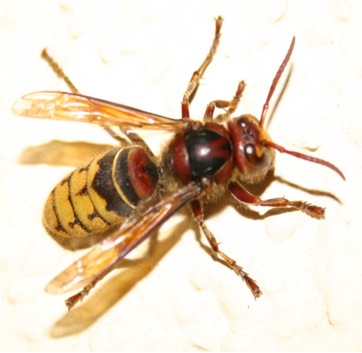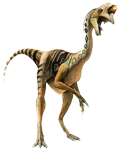Native Name: Charon
Enviroment: Arid-light jungle. Geographically extreme.
Charon is the only planet in the Tekandrova A/B system.
Tekandrova is exceptional in being a twin star system, however, it is unique in that both Tekandrova A and B have long since gone Supernova.
Both black holes orbit each other, swinging past each other eternally getting closer and closer.
Through cosmic coincidence, Charon's orbit keeps it from being sucked into either blackhole eternally. It travels inbetween the two black holes as they pass each other, but by the time they reach the apex of their swing, Charon reaches the far end of it's current black hole. It rapidly falls into the black hole, but before it reaches the horizon line, the combined momentum of it's orbit around the black hole, and the black holes acceleration towards it's partner ends up slinging Charon too close to it's neighbour, and it starts the cycle again, going around the other black hole.
As such, Charon eternally rings around them in a figure of eight, coming a few thousand kilometres away from total obliteration regularly throughout it's erratic year.
Light on Charon is provided by what is essentially a fire ball. A super dense mass of gas and rock orbits around Charon lazily, held in place by the conflicting gravitational pulls. Interestingly, when it is facing off into space, away from both Charon and it's parent singularities, it collects more fuel from the matter being dragged towards the two dying suns. Essentially, it burns with renewed vigour every day.
Regions: Entire planet is covered in extremes. mostly, it is an arid somewhat dusty planet but with heavy jungles sprouting up in parts, mainly in the mountainous areas. The geography of the planet is twisted beyond belief in some regions. the tug of war pull of gravity between Tekandrova A and B have elongated the planet, however, it does not experience the seasons of other tilted planets, as it's source of light, or 'sun' orbits it, instead of the other way around. Charon has no recognisable poles.
in some regions of the planet, huge towering pillars of rock have sprouted up, mountains twisted out of shape by close call incidents with Tekandrova.
Dominant Species: Raka-anra
Technology level: Primal/Scavanging
Animal life: Paka-anra, Darma-anra, four legged mammal life, diverse birds, small oceanic life forms.
---
name: Paka-anra
Description: Essentially large ants, with up to 8 limbs. Fore limbs have hands with opposable thumbs.
Diet: Omnivorous
natural abilites: Co-operation, gene growths, opposable thumbs
history: The Paka-anra are quite intelligent, working in large colony groups. They can cultivate plants and coloneys often form a symbiotic relationship with their habitat. Depending on one's inclination, the Paka-anra are either domesticated by the more aggressive Raka-anra or enslaved.
The Raka-anra allow the Paka-anra to thrive where in certain areas, allowing them to cultivate areas to grow food. Paka-anra are much more capable of defending important plant life from other predators than the Raka-anra, so the Raka leave them mostly alone so that they can exploit the abbundance of food themselves. The Raka-anra also prey on the Paka-anra, often raiding colonys, capturing and killing and bringing their prey home as for food. The Raka-anra some times take larve as well, to intentionally create a new Paka-anra colony or to 'domesticate' some Paka-anra for a particular task (When domesticated Paka-anra have served their purpose, they are usually devoured.)
While intelligent as far as animal life is concerned, and considered sentient by some, the Paka-anra consider this relationship as the natural course of life. The death of a worker is nothing to the colony as a whole. While the Raka-anra benefit much more than the Paka-anra in the long run, the Paka do recieve some benefit in protection from predators. While the Raka do inflict many casualties on the colony, it is still able to grow. If the Raka were to ignore a Paka colony, it is very possible that a larger predator would arrive with no concept of preserving balance and completely decimate the colony.
The Paka-anra is separated into the usual castes of workers and warriors
---
name: Darma-anra
Discription: Huge predatory beetle like creatures
Diet: Carnivorous
---
name: Raka-anra
Description: The Raka-anra generally resemble Hornets, but every caste is different.

Your typical Raka-Anra is about 4 metres long and one and half metres tall when low to the ground. Colours vary from yellow and black to red and black or to pure black.

Not shown in pictures:
The Raka-Anra have extremely long legs, and when 'standing' at their tallest, can be over 3 metres tall. Their limbs are much stronger than the hornet pictures shown here, and longer too. In addition, the Raka-anra's limbs end in varying graspers or tools depending on their caste. (eg: scythes, or claws)
Unlike hornets, the Raka Anra generally stand half way through flat to the ground and full height, keeping their leg's bent in a cage like stance.
Raka-Anra hold 2 pairs of wings for a total of four. While they fold next to each other while idle, in flight, the wings operate in opposite pairs, making them extremely manoeuvrable.
Raka-Anra have two smaller limbs close to their chest, which are unnoticeable most of the time. They can hold cargo with these, keeping their main limbs free to work or fight.
Raka-Anra also bare a number of 'bond-points' along their body, generally on their shoulders or chests. More will be explained under Castes.
Diet: Omnivorous
natural abilities: Explained further under 'Castes'
Commonly, Raka-anra are armed with powerful stingers full of nuero toxin, strong limbs, hard carapace and powerful wings.
Most (but not all) Raka-anra have inner proboscis which they can use to probe other creatures. This violent procedure allows them to absorb their targets knowledge. Being already quite intelligent, they can instantly put this knoweledge to use. For instance, they could learn an alien language and speak it effectively. (however, emotions would be muddled up and would not make sense to most native speakers)
History-sociality description: The Raka-Anra race is an accomplished species of startling intelligence given it's primal status. Thousands of years ago, they spread over their entire planet. Every Raka-anra queen is linked telepathically and as such, the species is completely unified. Being highly resourceful, they domesticated the Paka-anra, careful not to damage the population when feeding. The Raka-Anra live in hive structures, colonies of individuals working together, generally in underground networks. Hives can be small or impossibly large, depending on their environment and diet.
Castes:
The Raka-Anra are split into numerous Castes, with hundreds of variations. Essentially, there are three main castes of Raka-anra. Augmentals, Bee's and finally Tyrants.
Augmentals are small and serve a single purpose generally. Bee's are your typical Raka-anra, such as warriors and workers, and then Tyrants consist of Queens and the such.
However, not only do each of these castes have their own variations, but they can connect together into colonies of organisms operating with a single purpose. Generally, Augmentals will form symbiotic colonies with Bees and Tyrants. (Imagine a Portuguese Man-o-War on a much smaller scale and with a single host creature)
This is partially the explanation behind the huge amount of castes. When an Augmental bonds to a Bee, it changes it's genetic make up. Originally, many of the worker's vital organs were augmentals, eventually replacing the original ones throughout the centuries. Through this, the Raka-anra race evolves rapidly, combining natural selection with self determination and cutting reproduction out of the loop entirely. Raka-anra reproduction serves no purpose other than to bolster numbers. An interesting result of this is that the Raka-anra don't decline if for some reason bad genes survive, as with other species.
Scientifically (or as scientific as I can get), when a Raka-anra individual bonds with an augmental or another caste, both organisms copy each other's genetic code. Workers for instance, would bond with an augmental organism capable of breathing Sulphur dioxide. The worker could then work in Sulfer environments by letting the augmental breath for it, forming a symbiotic relationship. The hive's queen will continuously produce new workers, but to speed the process up, it produces the worker with it's augmental simultaneously, as the worker/sulphur augmental combination has proven itself successful. By maintaining a link with it's various subjects, the Queen will take note of what organs have failed (from lack of use, for example) and phase these out of new generations, thus, permanently mutating the caste to specialise in working in those particular environments.
Faction
Name: The Raka-anra 'chain'
Leading Body: The chain is presided over by an assembly of Queens of all it's world's hives. The queens are further grouped by planet and geographical location. For example, the Queen's of charon's northern hemisphere may discuss and decide on local matters, or take part in planet wide debates to confront larger issues, but then all of Charon's queen's together may interact with the queens of the other other raka-anra colonised worlds. This gives the species as a whole it's direction
Capital: Black Alpha, considered their 'home' hive on Charon. Black Alpha does not have any special privalges over other hives, but considers itself the protector of the entire race's collective knowledge. The Black Alpha queen takes great pride in this role and commands the respect of even the most far flung hive on the edge of known space.
Technology Level: Primal / Interstellar. Dependant on sub faction
Inhabitants: Hives on various worlds, every hive is considered a sub faction of the Raka-anra chain.
Philosophy: Expansion and glory. Every Raka-anra has an instinctive compulsion to better their hive, to improve something. A typical drone raka-anra with no accomplishments feels no self worth. Only when they have achieved something for the Raka-anra, will an individual accept itself. As a result, the Raka-anra are extremely committed to what they do.
History:
The Raka-anra are odd in their aggressiveness. As a race, they could sustainably expand without any conflict. They can spread to other planets through long range spores and their bizare form of space travel, all based around their appocolyptic parents, Tekandrova A and B. However, they are drawn to hunting and subjugating other species, using them in some way. One of the contributing factors to the Raka-anra's fast evolution is that a hive won't simply sit still. Individuals constantly explore, often nomadically, only returning when they have found something useful to the hive. In the case of other races, often huge wars could be fought with massive loss of life, with very few Raka-anra surviving and returning to their hives. However, each of those Raka-anra will bare the knowledge gained by the entire swarm, information which will greatly benefit the Hive.
This occurs even when the Hive needs no improvements. It is a thing of honour, a Bee with no contribution to society is a Bee without worth. Raka-Anra which have yet to complete this rite are often referred to as drones. After their return, they gain elevated status, for example, a warrior drone might become a Thinker Bee on it's return. Elevated Bee's will often take part in invasionary forces to instruct and augment the local forces.
A Raka-anra invasion will generally start with a scout. The scout carries hundreds of eggs and can inject them into any number of organisms, which will hatch rapidly, feeding on their hosts and growing swiftly. Within a week or two, a whole hive of Raka-anra can have formed. The scout can release a signal which will call it's home hive (on an interplanetary scale) to mark the planet as a target. The hive will often dispatch spores to help with colonisation. However, the 'insurgency' will not be able to properly communicate with the other Hives until they produce or receive their own Queen. An insurgency can rapidly intensify and explode beyond containment during this period, as the Hive experiences rapid advance to match the maturity of other Hives.
Currently the Raka-Anra inhabbit over 7 planets, all in different systems.


